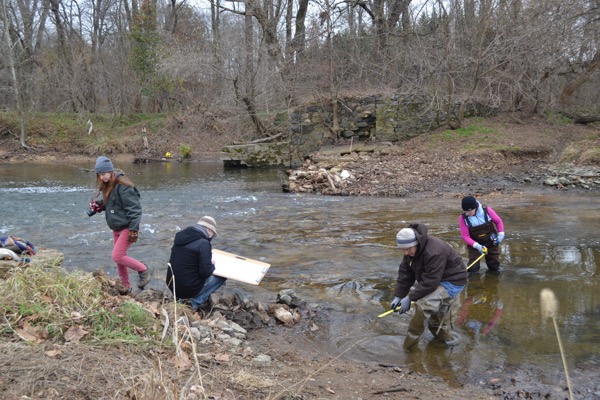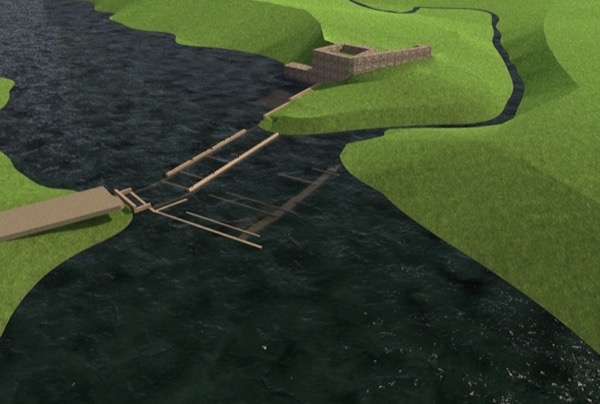


Revolutionary change
UD removes historic dam to restore anadromous fishery along White Clay Creek
1 p.m., Jan. 30, 2015--For the first time since the American Revolution, resident and anadromous fish will be able to spawn and swim freely from tidewater to freshwater in the Piedmont Basin along the White Clay Creek National Wild and Scenic River near the University of Delaware campus in Newark.
On Dec. 4, 2014, hydrologists and historians from UD’s School of Public Policy and Administration (SPPA) worked with a contractor to breach and remove 40 feet of the historic Byrnes Mill Dam at Delaware Park. This is the first recorded dam removal for fish passage in the state of Delaware.
Campus Stories
From graduates, faculty
Doctoral hooding
“The deconstruction of this historic dam will reopen close to four miles of the national wild and scenic river for spawning by domestic and anadromous fish such as the striped bass, American shad, and river herring," said Gerald Kauffman, principal investigator on the project and project director at the Water Resources Agency (WRA), a unit of SPPA's Institute for Public Administration.
The removal connects 3.5 miles of the White Clay Creek National Wild and Scenic River to the tidal Christina and Delaware Rivers. This is the first of seven planned dam removals along the creek between sea level and the Delaware-Pennsylvania state line.
UD’s interdisciplinary team
WRA led the project with $190,000 in grant funding from the American Rivers and the National Oceanic and Atmospheric Administration (NOAA) Community-based Restoration Program, the National Fish and Wildlife Foundation, the FishAmerican Foundation and the National Park Service.
WRA researchers Kauffman, Martha Narvaez and Andrew Homsey worked in collaboration with Rebecca Sheppard and Catherine Morrissey of SPPA’s Center for Historic Architecture and Design (CHAD).
Historical significance
The research team discovered that in 1777 Daniel Byrnes constructed White Clay Creek Dam No. 1 as a 13-foot high, 100-foot long timber-crib-and-rock fill structure.
The dam was built to divert water into a mile-and-a-half long raceway that provided hydropower for a colonial mill at the nearby Hale Byrnes House.
Byrnes built the first mill at this location. He and his brother Caleb operated a previous mill along the Brandywine River in the 1760s.
Byrnes started acquiring land along the White Clay Creek in 1773, and he purchased the last of four parcels of land in 1777. After examining the historic fabric of the mill, the research team confirmed that the material that still survives at the site is from the late 18th century.
“What makes this so significant from a historic preservation perspective is the age of the structure, and the construction methods used to build it. We were able to learn a lot about early milldam construction by examining the Byrnes milldam,” said CHAD’s Morrissey. “There are pattern books and guides on how to build dams but these aren't published until almost a century after this milldam was constructed. It is a wonderful example of 18th century milldam construction -- one of the only known resources of its type.”
In September 1777, American troops crossed the White Clay Creek at the bridge near the Byrnes mill on their way from the Battle of Coochs Bridge to the Battle of the Brandywine. They seized 40 wagons full of flour and grain, along with eight large cheeses, to prevent the British from capturing the goods.
Ironically, the British troops crossed the creek several miles away from the mill.
Historical preservation
In addition to being the first dam removal in Delaware and one of just six projects during the annual grant cycle funded by the American Rivers-NOAA River Grants program in the United States, the project required unique collaborations and partnerships to document the dam’s history and construction details.
The 237-year-old dam was hand built by the miller Byrnes to withstand countless floods and droughts over the centuries. The 20-30-foot long colonial era pine and oak timbers, hand forged iron spikes (some as long as four feet), and quarry stone were pulled from the breach and stockpiled for historic documentation by historians and archeologists from CHAD.
The UD Facilities department has provided warehouse space at the Science, Technology and Advanced Research (STAR) Campus for CHAD to examine and preserve the artifacts.
Student involvement
More than 20 students from nine disciplines conducted field work for the planning and design of the project, earning bachelor’s degrees in civil and environmental engineering (Ian Kaliakin, Jordan Deshon, David Specht, Lawrence Latour, Dustin Briggs), chemical engineering (Erica Addonizio), environmental studies (Kelsey Wentling, Caren Fitzgerald, Thomas Santangelo, Kayla Iuliano, Seth Olson), natural resources management (Emily Baumbach), biological sciences (Kevin M. Archibald), water science and policy (Kate Miller), and master’s degrees in urban affairs and public policy (Leah Kacanda and Riley Hollenbaugh), and historic preservation (Laura Keeley, of the Class of 2012; Hannah Blad, of the Class of 2014; Michael J. Emmons Jr., of the Class of 2014; Kevni Barni; Travis Olsen; Megan Hutchins; and Sara Bartram.)
Project partners
The effort required the assistance of the owner Delaware Racing Inc. (John Mizikar and Ryan Kidwell), contractor Merit Construction (Vince Dills, a 1989 UD alumnus), Duffield Associates (David Gosse and David Diefenthaler), Delaware State Historic Preservation Office (Craig Lukezic), American Rivers (Laura Craig), NOAA (Mary Andrews), National Park Service (Julie Bell), and White Clay Creek National Wild and Scenic River Manager (Shane Morgan).
“We are happy to have worked with such a diligent group of partners on the removal of the Byrnes Mill Dam. Not surprisingly, the first dam removal project for any group is also the most challenging, yet this group of project partners was able to successfully navigate the process and ended up with a project that has both ecological and cultural value. We look forward to removing more dams in Delaware to restore rivers and benefit fisheries,” said Laura Craig, director of River Restoration at American Rivers.
Media coverage
The project has received wide media coverage. To view photos from the dam removal process, see the News Journal article.
It also was featured in a Jan. 28 National Geographic article on the growing movement to remove dams.









